It looks like you're using an Ad Blocker.
Please white-list or disable AboveTopSecret.com in your ad-blocking tool.
Thank you.
Some features of ATS will be disabled while you continue to use an ad-blocker.
5
share:
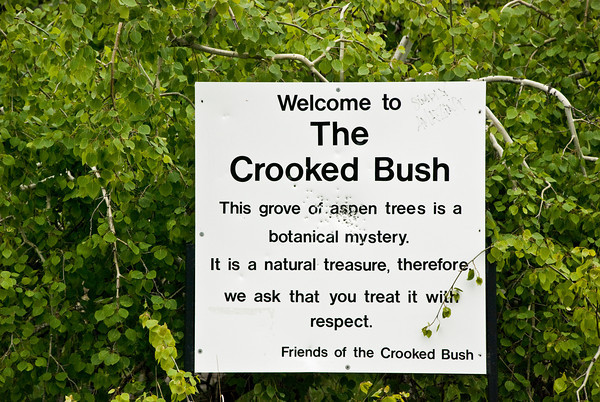
Source
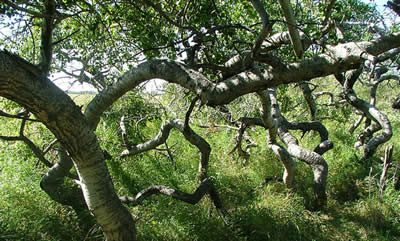
Among the world’s strangest places, is a grove of aspen trees that are so twisted and gnarled, that many locals attribute them to ghosts, UFOs and aliens. Near the quiet town of Alticane, in north-central Saskatchewan, lies a grove of gnarled trees surrounded by perfectly normal ones.
The crooked trees are so knotted and bent, they look eerily like the curled legs of dead, overturned spiders. Nobody has ever been able to fully explain the abnormality, but theories range from contaminated soil, to genetic mutation of aspen trees, and the impact of meteorites. A local farmer even claims to have seen aliens urinating in the area before the trees began sprouting in the 1940s, and Alticane is located in an area well known for UFO sightings.
Perhaps that explains why so many visitors to the grove feel a strange presence, almost a supernatural force that causes dizziness as they stroll along the wooden boardwalk. Despite a lack of fencing, cattle will not go near the grove, and superstitious people won’t go near it during a full moon.
This is another one of those subjects which intrigues me and I had to do more research on it and share it with all of you. The fact that this is the only place where these aspens grow like this is quite crazy and should be investigated, IMO.
And as for the thought of aliens urinating on them, well, we will have to try and find a better solution than that.
Source
Well, we always knew there was more to Saskatchewan than grain elevators and waving wheat. For one thing… there’s the crooked trees!
The trees, growing on a farm in The Thickwood Hills, northwest of Saskatoon, has become a hot spot for fans of the strange and unusual.
Essentially, the crooked trees are a grove of genetically mutated aspens, but the local folklore surrounding the origins of these trees is what makes them truly wondrous. For instance - one story posits the trees are a result of “alien urine.” This wonder offers us a chance to shed that “boring Canadian” image and go for something a little bit more… peculiar.
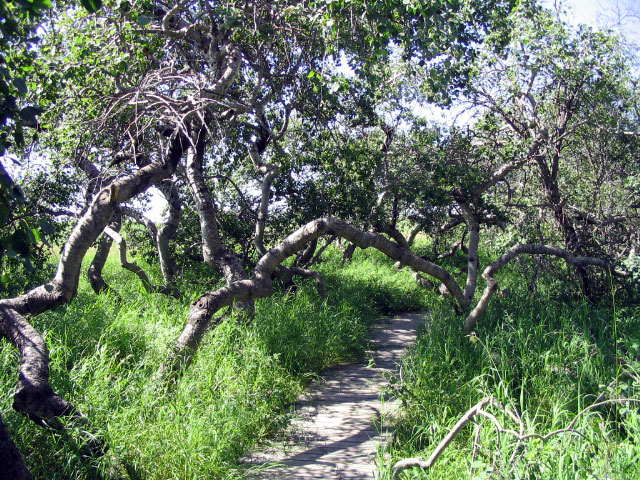
Source
From the earliest times forests have been a place where those who seek knowledge and wisdom venture. This idea has become imbedded into our collective psyche through religion, myths, and stories. Whether it be “The Tree of Enlightenment” from Buddhism, or when Jesus of Nazareth ventured into the wilderness to confront good and evil. In Norse mythology, axis mundi or the center of the world was Yggdrasil or the “World Tree”. In literature, Henry David Thoreau decided material wealth does nothing to augment happiness and withdrew to Walden - a cabin in the forest - to experience the divine through nature. This idea of nature imparting wisdom to those who choose to see was never more succinctly stated when the Cherokee Indian, Chief Sequoia said, “To be one with the trees is to know Life within your own spirit.”
Source
They have been studied by researchers at the University of Saskatchewan and at the University of Manitoba. Rick Sawatzky from the University of Saskatchewan grew trees at the university from cuttings taken from the twisted trees. They grew in the same twisted formation at the university as they had in their natural setting, showing that the mutation was due to the characteristics of the plant, not the soil or location.
Dr. Bill Remphrey from the University of Manitoba also took cuttings from the grove and grew and studied them in Manitoba. The research became the M.Sc. thesis topic for graduate student Ashley Linden. His thesis, published in 2006, studied the plant characteristics that led to the unusual bending and twisting of the trees.
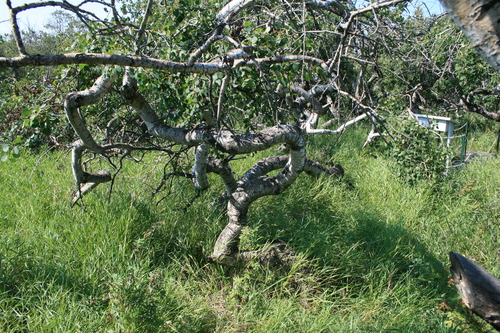
Source
Because of the importance of the bending in creating the crooked form, we have initiated studies to try and determine what causes the bending.
There is some evidence that lack of strength of the shoots at critical times during the growing season may be involved.
The MSc Thesis of a graduate student, Ashley Linden looked at anatomical differences of the stems on the upper and lower sides of the bend. He has noticed that phloem fibres on the upper side do not develop fully compared to the lower side and compared to all locations around wild type trees. He has also conducted strength experiments using weights and preliminary results suggest that strength may be involved.
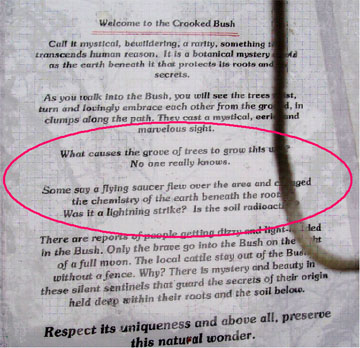
What normal Aspens look like everywhere else.
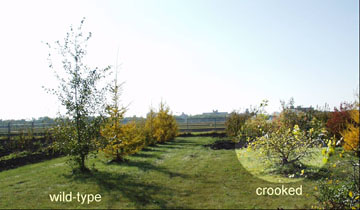


As you can see normal Aspens grow straight up. Weird that in just one place they grow so crooked and it has nothing to do with the soil or environment.
I looked around before on this subject and couldn't find anything on crooked aspens, so if this topic has been covered before my apologies, but hey, I spent time on it and thought I would share it with all of you.
So I bring the evidence before the people of ATS, what do you think affected the trees in just this one part to grow the way they do? Perhaps aliens? Radiation? Or.... alien urination?
Thanks, and I hope you enjoy this story as much as I do.
Any thoughts?
Pred...
reply to post by predator0187
Sorry, but I have to say the answer is in plain English at least twice, that the trees are that way due to a genetic mutation. Did you even read what you pasted here?
There is no mystery as far as I can tell...
Sorry, but I have to say the answer is in plain English at least twice, that the trees are that way due to a genetic mutation. Did you even read what you pasted here?
There is no mystery as far as I can tell...
reply to post by daynight42
I think you missed my point. What caused the genetic mutation. The crooked trees have been in this one part for 60 years, why have they not spread? There are genetic mutations in crop circles as well, just wondering if people think could be similar.
I was just saying is it just interesting and wondering if it was just an act of nature or has something influenced it.
Pred...
I think you missed my point. What caused the genetic mutation. The crooked trees have been in this one part for 60 years, why have they not spread? There are genetic mutations in crop circles as well, just wondering if people think could be similar.
I was just saying is it just interesting and wondering if it was just an act of nature or has something influenced it.
Pred...
reply to post by predator0187
Mystery solved-
I remembered seeing this a few years ago. But apparently Aspen trees can grow and spread through underground growth via a means of asexual reproduction. Apparently, the LARGEST organism on earth is a grove of interconnected aspen trees totalling almost 50,000 upshoots.
waynesword.palomar.edu...
This is most likely a case of a mutated strain of Aspen trees growing in this manner. which would explain their configuration.
Mystery solved-
I remembered seeing this a few years ago. But apparently Aspen trees can grow and spread through underground growth via a means of asexual reproduction. Apparently, the LARGEST organism on earth is a grove of interconnected aspen trees totalling almost 50,000 upshoots.
waynesword.palomar.edu...
An aspen clone in the Wasatch Mountains of Utah is composed of 47,000 stems of genetically identical aspen trees (Populus tremuloides), with a total weight of 6 million kilograms (6,500 tons). Since the aspen is a dioecious species (with separate male and female individuals in the population), this monstrous clone is the same sex, in this case all males. The clone has developed asexually by suckering, where new adventitious stems arise from a gigantic spreading root system. Suckering is a common method of asexual reproduction in the willow family
This is most likely a case of a mutated strain of Aspen trees growing in this manner. which would explain their configuration.
Just an act of nature has causes. I feel as others that this a genetic mutation, as I have seen willow trees with bent branching similar to the
photos. A gamma ray from space could have caused the mutation thats natural. If a fly over by a UFO caused it wouldn't that be natural as well.
reply to post by predator0187
The "normal" straight-standing aspens at the end of your post look like birches to me. Are they a closely-related species?
They both have white bark, for starters.
The "normal" straight-standing aspens at the end of your post look like birches to me. Are they a closely-related species?
They both have white bark, for starters.
reply to post by predator0187
OK. Sorry, I didn't understand.
I suppose then the question is how common are genetic mutations in trees and how easily do they spread?
OK. Sorry, I didn't understand.
I suppose then the question is how common are genetic mutations in trees and how easily do they spread?
This is verrry interesting, as far as speciation goes. There is nothing really WRONG with these trees, if you think about it.... if all aspens had
grown this way and there was a small grove growing straight up, we'd be trying to figure out what mutation made there phloem strength increase.
I imagine, like most experiments in speciation, (think how humans affected dog, bird, flower, and other species) given they can reproduce via cloning, all it took was one tree to be a little different.
This happens all the time, naturally. Only, most mutations are generally bred out by the more 'successfull' larger groups of that species (or irradicated by human intervention).
As a side note I can't help thinking about evolution and the stigma that our DNA somehow consciously is moving towards perfection... I'm affraid the chaotic order that is nature's paradox cares not for advancement, only survival, with a pinch of randomness for good measure. Not everything survives and nothing is perfect.. ever
I imagine, like most experiments in speciation, (think how humans affected dog, bird, flower, and other species) given they can reproduce via cloning, all it took was one tree to be a little different.
This happens all the time, naturally. Only, most mutations are generally bred out by the more 'successfull' larger groups of that species (or irradicated by human intervention).
As a side note I can't help thinking about evolution and the stigma that our DNA somehow consciously is moving towards perfection... I'm affraid the chaotic order that is nature's paradox cares not for advancement, only survival, with a pinch of randomness for good measure. Not everything survives and nothing is perfect.. ever
reply to post by daynight42
Genetic mutations generally work the same across the board for all plant and animal species.
Basically, the offspring receives half of its DNA from each parent. However, the DNA provided by each parent isnt exactly Identical to the parents own personal DNA, it will be very similiar, but it will have some differences.
Now, each mutation will have a chance to be present in the offsprings DNA, but its not guaranteed. Theres a lot more that goes into this such as gene expression and recessiveness of a gene. An offspring could get the mutation, even a recessive form of it, and not even express the mutation, and yet still pass it on.
However, these aspen trees, as i pointed out earlier, have a very high probability of being all the same tree, just spreading Asexually through roots/shoots. Which would explain the configuration of the grove. So this mutation isnt even being passed on sexually, all of the trees are more than likely just new growth of an older mutated tree.
Genetic mutations generally work the same across the board for all plant and animal species.
Basically, the offspring receives half of its DNA from each parent. However, the DNA provided by each parent isnt exactly Identical to the parents own personal DNA, it will be very similiar, but it will have some differences.
Now, each mutation will have a chance to be present in the offsprings DNA, but its not guaranteed. Theres a lot more that goes into this such as gene expression and recessiveness of a gene. An offspring could get the mutation, even a recessive form of it, and not even express the mutation, and yet still pass it on.
However, these aspen trees, as i pointed out earlier, have a very high probability of being all the same tree, just spreading Asexually through roots/shoots. Which would explain the configuration of the grove. So this mutation isnt even being passed on sexually, all of the trees are more than likely just new growth of an older mutated tree.
new topics
-
Big Storms
Fragile Earth: 45 minutes ago -
Where should Trump hold his next rally
2024 Elections: 3 hours ago -
Shocking Number of Voters are Open to Committing Election Fraud
US Political Madness: 4 hours ago -
Gov Kristi Noem Shot and Killed "Less Than Worthless Dog" and a 'Smelly Goat
2024 Elections: 4 hours ago -
Falkville Robot-Man
Aliens and UFOs: 5 hours ago -
James O’Keefe: I have evidence that exposes the CIA, and it’s on camera.
Whistle Blowers and Leaked Documents: 5 hours ago -
Australian PM says the quiet part out loud - "free speech is a threat to democratic dicourse"...?!
New World Order: 6 hours ago -
Ireland VS Globalists
Social Issues and Civil Unrest: 7 hours ago -
Biden "Happy To Debate Trump"
2024 Elections: 7 hours ago -
RAAF airbase in Roswell, New Mexico is on fire
Aliens and UFOs: 7 hours ago
top topics
-
A Warning to America: 25 Ways the US is Being Destroyed
New World Order: 17 hours ago, 21 flags -
Blast from the past: ATS Review Podcast, 2006: With All Three Amigos
Member PODcasts: 9 hours ago, 13 flags -
James O’Keefe: I have evidence that exposes the CIA, and it’s on camera.
Whistle Blowers and Leaked Documents: 5 hours ago, 12 flags -
Biden "Happy To Debate Trump"
2024 Elections: 7 hours ago, 12 flags -
Australian PM says the quiet part out loud - "free speech is a threat to democratic dicourse"...?!
New World Order: 6 hours ago, 12 flags -
Mike Pinder The Moody Blues R.I.P.
Music: 10 hours ago, 8 flags -
What is the white pill?
Philosophy and Metaphysics: 9 hours ago, 6 flags -
Shocking Number of Voters are Open to Committing Election Fraud
US Political Madness: 4 hours ago, 5 flags -
Ireland VS Globalists
Social Issues and Civil Unrest: 7 hours ago, 5 flags -
RAAF airbase in Roswell, New Mexico is on fire
Aliens and UFOs: 7 hours ago, 5 flags
active topics
-
"We're All Hamas" Heard at Columbia University Protests
Social Issues and Civil Unrest • 292 • : TheWoker -
I am beholden to my truth, of which I share with you now.
Dreams & Predictions • 24 • : BrotherKinsMan -
Big Storms
Fragile Earth • 6 • : lilzazz -
Gov Kristi Noem Shot and Killed "Less Than Worthless Dog" and a 'Smelly Goat
2024 Elections • 32 • : RazorV66 -
Starburst galaxy M82 - Webb Vs Hubble
Space Exploration • 11 • : Arbitrageur -
Candidate TRUMP Now Has Crazy Judge JUAN MERCHAN After Him - The Stormy Daniels Hush-Money Case.
Political Conspiracies • 817 • : RazorV66 -
Post A Funny (T&C Friendly) Pic Part IV: The LOL awakens!
General Chit Chat • 7137 • : PorkChop96 -
Massachusetts Drag Queen Leads Young Kids in Free Palestine Chant
Social Issues and Civil Unrest • 21 • : ToneD -
Biden "Happy To Debate Trump"
2024 Elections • 49 • : TheMisguidedAngel -
Where should Trump hold his next rally
2024 Elections • 13 • : Edumakated
5
